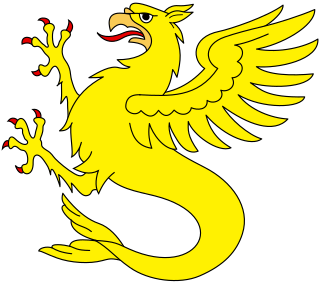Ernest II, Count of Mansfeld-Vorderort (6 December 1479 - 9 May 1531, Artern) was a German nobleman from the Mansfeld-Vorderort line of the House of Mansfeld. He was the fifth child and third son of Albert III (V), Count of Mansfeld, Lord in Mansfeld and Lord in Heldrungen (c.1450 - 3 December 1484, Leipzig) and succeeded him on his death.
His first marriage was in Stolberg in 1500 to Barbara von Querfurt (c 1485 - 23. January 1511), daughter of Bruno VII (IX), the last lord (Herr) of Querfurt, and his wife Brigitte zu Stolberg (1468–1518).
Ernest's second marriage was to Dorothea, Countess at Solms-Lich (25 January 1493 - 8 June 1578, Mansfeld), daughter of Philip, Count of Solms-Lich (1468) and his wife Adriana von Hanau-Münzenberg (1470–1524). Two of his children by his second marriage were the military commander Peter Ernst I von Mansfeld-Vorderort (1517-1604) and Elisabeth (ca. 1516–1541), briefly wife of Frederick, Hereditary Prince of Saxony.
He was buried in the St Andreas Kirche in Eisleben.
He is an ancestor of the Brazilian imperial family by the Empress Maria Leopoldina of Brazil.
Lambert II, Count of Lens was a French nobleman. He was born about 1030 making him about 24 years old at his death in 1054.

Richard III was the duke of Normandy who reigned from August 1026 to his death. His brief reign opened with a revolt by his brother.

Baldwin III, called the Young, was Count of Flanders, who briefly ruled the County of Flanders together with his father, Arnulf I, from 958 until his early death.

Countess Friederike Charlotte Antoinette of Dohna-Schlodien in Leistenau was a German noblewoman.
William III was the count and margrave of Provence from 1014 to his death. He inherited the titles of his father Rotbold II but preceded his cousin William IV as count.
Countess Katharina Dorothea Elisabeth Finck von Finckenstein was a member of the German noble family Finck von Finckenstein.

The House of Henneberg was a medieval German comital family (Grafen) which from the 11th century onwards held large territories in the Duchy of Franconia. Their county was raised to a princely county in 1310.

Baldwin II of Boulogne was a son of Arnulf III, Count of Boulogne, whom he succeeded as count of Boulogne.

The Swienca family was a medieval Pomeranian noble family which held high offices under various political powers in the Lands of Schlawe and Stolp and Pomerelia from the mid-13th to the mid-14th centuries.
Dudo of Laurenburg, German: Dudo von Laurenburg, Latin: Tuto de Lurinburg, was probably Count of Laurenburg and is considered the founder of the House of Nassau. The House of Nassau would become one of the reigning families in Germany, from which are descended through females the present-day royals of the Netherlands and Luxembourg, while officially belonging to this House.
Rupert I of Laurenburg, German: Ruprecht I. von Laurenburg, was count of Laurenburg and one of the ancestors of the House of Nassau.
Arnold I of Laurenburg, German: Arnold I. von Laurenburg, was count of Laurenburg and an ancestor of the House of Nassau.
Ermengarde of Anjou was the Countess of Rennes, Regent of Brittany (992–994) and also Countess of Angoulême.
Carl Ludwig II, 5th Prince of Hohenlohe-Langenburg, was the eldest son of Ernst I, Prince of Hohenlohe-Langenburg. He was the fifth Prince of Hohenlohe-Langenburg.
Johanna Sibylla of Hanau-Lichtenberg was the first child of Philipp V, Count of Hanau-Lichtenberg from his first marriage with Countess Ludowika Margaretha of Zweibrücken-Bitsch (1540-1569).

Countess Elisabeth of Nassau-Siegen, German: Elisabeth Gräfin von Nassau-Siegen, official titles: Gräfin zu Nassau, Vianden und Diez, was a countess from the House of Nassau-Siegen, a cadet branch of the Ottonian Line of the House of Nassau, and through marriage Countess of Wied.
Otto I, Count of Scheyern was the earliest known ancestor of the House of Wittelsbach whose relation with the House can be properly verified.
Europäische Stammtafeln - German for European Family Trees - is a series of twenty-nine books which contain sets of genealogical tables of the most influential families of Medieval European history. It is a standard reference work for those researching medieval, imperial, royal and noble families of Europe.

Countess Joanne of Nassau-Siegen, German: Joanne Gräfin von Nassau-Siegen, official titles: Gräfin zu Nassau, Vianden und Diez, Frau zu Breda, was a countess from the House of Nassau-Siegen, a cadet branch of the Ottonian Line of the House of Nassau, and through marriage Countess of Waldeck.

Countess Adriana of Nassau-Siegen, German: Adriana Gräfin von Nassau-Siegen, official titles: Gräfin zu Nassau, Vianden und Diez, Frau zu Breda, was a countess from the House of Nassau-Siegen, a cadet branch of the Ottonian Line of the House of Nassau, and through marriage Countess of Hanau-Münzenberg.
This page is based on this
Wikipedia article Text is available under the
CC BY-SA 4.0 license; additional terms may apply.
Images, videos and audio are available under their respective licenses.






